Duke’s Foodie Culture
Unique culinary experiences satiate curious appetites
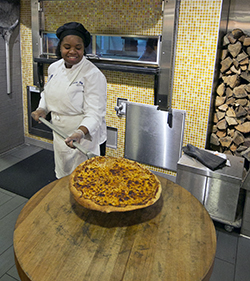
Spicy aromas of chicken jambalaya and Indian curry filled the Bryan Center on a recent afternoon, as students and employees like Jim Hodges anxiously waited for samples of eclectic fare.
The line wound through a nook next to the Louise Jones Brown Gallery, where environmentally-friendly plates with dollops of jalapeno hummus paired with pita, curry cauliflower and broccoli with golden raisins, and cups of vegetable soup made the rounds. The variety of locally sourced, vegetarian and vegan foods served during the tasting event will soon fill dishes at the West Union, which will include 13 new eateries when it reopens June 1 after an almost three-year renovation.
“A lot of times when you think of food on a campus, you think of fast food, but Duke Dining is really making it easy to find healthy choices with something that’s fresh and wholesome,” said Hodges, associate director of Conference & Event Services, who sampled hummus and roasted vegetables at the tasting event.
From new West Union eateries and upgrades at the East Campus Marketplace to farm-fresh produce at the campus farmers market, the culture of food at Duke is changing.
Even before renovated facilities opened, The Daily Meal, a popular online source for food news and trends, ranked Duke fifth last year among “Best Colleges for Food in America.” Like colleges across the country, students and employees at Duke are looking for unique culinary experiences and ways to satiate their curious appetites at a time when roughly half of Americans consider themselves “foodies.”
“Foodie culture is everywhere, but especially on college campuses, where students are more informed than ever in terms of thinking about where their food comes from,” said Dan Myers, senior eat/dine editor for The Daily Meal who picked Duke as No. 5 on his list of “75 Best Colleges for Food in America.”
Myers noted that Duke performed well on his list not only because of its quality of food, but because the university is part of a broader trend of colleges shifting toward greater variety, which includes more ethnic foods and catering to different dietary options, like vegetarian, vegan and gluten-free.
“Duke Dining aspires to be one of the top university dining programs in the nation,” said Rick Johnson, associate vice president of student affairs for Housing, Dining and Residence Life. “That means providing spaces that support community, great food and excellent customer service for an authentic experience in all sorts of ways.”
Lobster at Thanksgiving
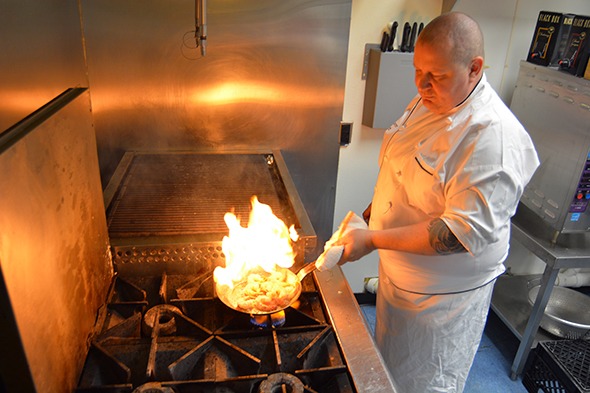
Among those working on food offerings at Duke is Jody McLeod, Duke Dining’s executive chef who once served in that same role for the 2010 Winter Olympics in Vancouver. McLeod, who started at Duke in November 2015, hopes to teach students and employees tips and tricks he’s working on for himself: how to eat healthier.
Over this past winter, McLeod put a personal touch on 800 recipes, ranging from merlot gravy and blue cheese butter sauces to vegetarian dishes like teriyaki chickpea loaded eggplant. Where he could, he made small changes to enhance nutritional value. To mimic flavor of a high-fat cheese, for example, he used lemon juice, nutmeg and aged cheese to reduce sodium content, reduce fat and avoid processed foods.
The creations are for the East Campus Marketplace, which recently reopened after its first renovation in 20 years with a greater focus on food, right down to a sustainable green wall of herbs inside the dining space of the building. Rosemary and basil, among other plants, occasionally find their way into dishes prepared in the dining hall.
An array of international dishes is in the works for the Marketplace – all part of a national trend that has some colleges expanding food options with exotic offerings.
“Vietnamese or Turkish – I want to be adventurous and inclusive because that’s the nature of food now,” McLeod said. “Our customers may not be able to go out to eat in Durham all the time, so I want them to have that great experience here on campus.”
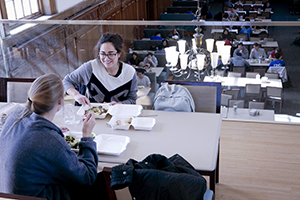
The new Marketplace also boasts more seating – a mezzanine level with floor to ceiling windows provides plenty of natural light – and a variety of exhibition-style cooking platforms welcome diners with dumplings, rotisserie chicken and artisan pizzas from wood-fired ovens.
The Marketplace’s leafy options are a favorite for Helen Gordon, unless she gets distracted by other choices, like a stir-fry bar or freshly cut meat.
“I’ll often walk over thinking I want a salad, but I get there and they may have roast beef and I change my mind,” said Gordon, an assistant professor in the School of Nursing. “The staff is so friendly and helpful, too. It’s not like any dining experience I’ve had on any other college campus.”
Gordon, a faculty-in-residence in East Campus’ Randolph Residence Hall, eats at the Marketplace three times a week. Originally, she planned her trips as a way to have more interaction with students but was wowed by the food the more she ate there. She was especially surprised at one option when she dined before Thanksgiving break.
“I never would have expected that at a Thanksgiving meal they would be serving lobster,” she said.
A culinary show space
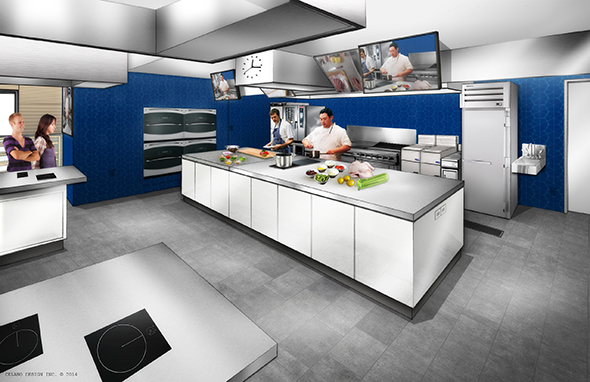
On West Campus, a renovation project on the 112,000-square foot West Union will match with McLeod’s efforts to create an innovative and cutting-edge campus dining space.
West Union will feature a culinary show space known as the “Chef’s Kitchen,” where students, faculty and staff will be able to get hands-on food education during weekly events. Equipped with 16 cooking stations, Duke community members can join chefs from Duke Dining and local eateries, who will walk through the creation of dishes. The space will also be used for academic classes.
“It’ll almost look like a TV studio with mirrors, speakers, cameras and screens to mimic the kind of experience you’d see on any professional cooking show,” said Robert Coffey, director of Duke Dining.
When the West Union is complete in June, it will also feature an open-atrium with 13 restaurants serving food from paella and Indian cuisine to vegan-friendly dishes. A new fine dining room, The Commons, has rooftop seating and scenic views of campus and its surrounding forest. The Commons kitchen will prepare USDA choice ribeye steaks on a 800-degree charbroiler.
The changes come from discussions with student government representatives and groups such as the Duke University Student Dining Advisory Committee, which worked closely with Coffey and other Duke Dining staff to determine the needs of diners on campus.
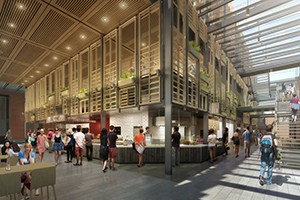
“We started putting together focus groups with a diverse group of students and employees to drive conversations about bringing truly authentic cuisine to campus,” Coffey said. “Food is such a passionate subject, and we wanted to find options that would excite people.”
Among the new eateries at West Union is Devil’s Krafthouse, which is operated by the owner of Durham’s Geer Street Garden and The Boot. It opened in February as the first new eatery in the renovated West Union. Doubling as restaurant and bar, Duke community members can select locally-produced beers, enjoy pub food and watch sporting events on big-screen TVs.
Damion Moore, co-owner of Dame’s Chicken & Waffles in downtown Durham, noted that changes in food culture at Duke can be seen as part of larger cultural impacts throughout the city. In recent years, Durham has been recognized for its food scene by the New York Times, Zagat, Bon Appetit and was named the South’s “Tastiest Town” by Southern Living magazine.
“The change in Duke’s food is a reflection of Durham itself,” said Moore, who opened a satellite restaurant on Central Campus last fall. “Durham has become a place where restaurateurs are encouraged to try new things, and what keeps us relevant and on the cutting edge will help entrepreneurs thrive at Duke, too.”
A top college farmers market
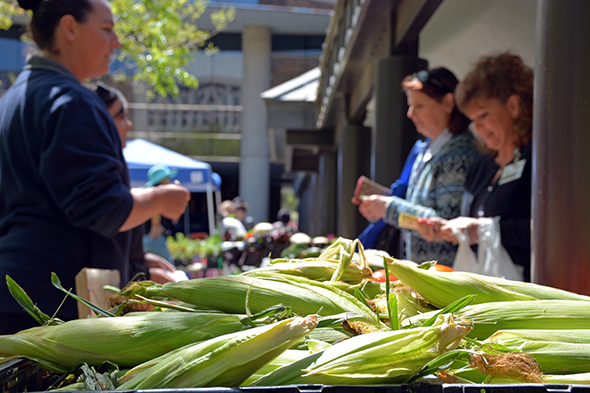
Campus foodies are thriving outside, too.
Since 2000, the Duke Farmers Market has stood as one of the first progressive food opportunities on campus and has been named among the country’s best college farmers markets.
“We know more employees are focusing on their well-being, so it’s important to provide a way to find good, fresh food steps from where we all work,” said Cassandra Callas, health education specialist with LIVE FOR LIFE, Duke’s employee wellness program that organizes the market. “Shoppers can enjoy seasonally grown food while supporting our local community, too.”
Duke has worked to expand its reach with local farmers through the weekly market, which opens April 29. Farmers come to campus each Friday from nearby towns like Hillsborough, Rougemont and right in Durham to offer fruits, vegetables, breads and more. The Duke Campus Farm, located seven miles from campus, also offers carrots, leafy greens and beets for sale at the market.
“It’s a good feeling when you can step outside from your daily routine and be able to talk to farmers as they’re bringing in their own products,” said Brian Livingstone, a neurodiagnostic information systems technologist in the Health System and regular Duke Farmers Market shopper. “It’s a place where you find the kind of raw ingredients you’d want to take home to your own kitchen.”
Piece by piece, Duke is creating a list full of unique foods and learning opportunities that satisfy its community’s hunger for ways to think about, create and enjoy food.
“The market is one of the personalized experiences we have that makes Duke stand out,” Livingstone said. “It shows there is a lot of desire in food and what it means.”